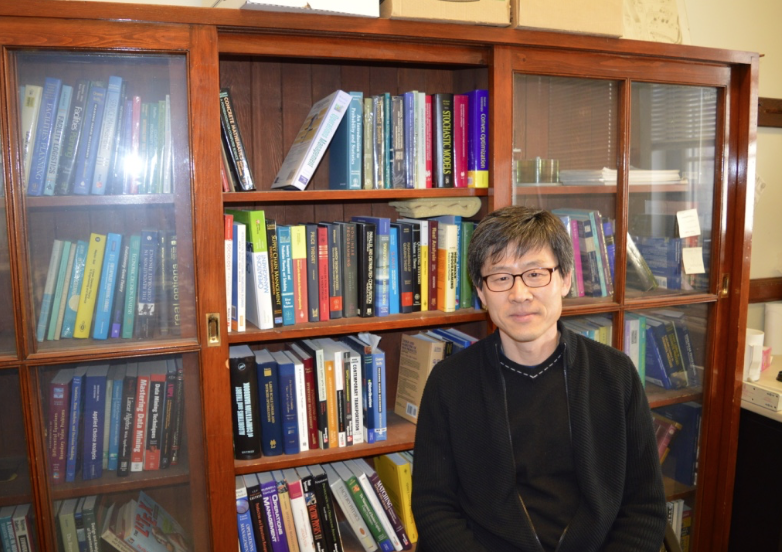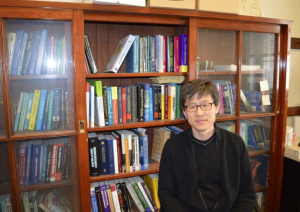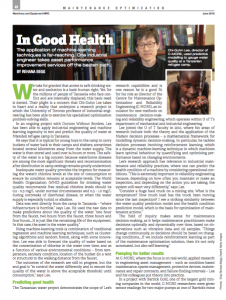
In good health – innovative applications for machine-learning tools
The application of machine-learning techniques is far-reaching. One industrial engineer takes asset performance improvement services off the beaten path.
June 22, 2018 | By Rehana Begg


Dr. Chi-Guhn Lee, director of C-MORE in Toronto, applies industrial engineering and machine-learning methods to advance maintenance decision-making. Photo: Rehana Begg.
We take for granted that access to safe drinking water and sanitation is a basic human right. Yet, for the millions of people of Tanzania who face conflict and are internally displaced, this basic need is denied.
Their plight is a concern that Chi-Guhn Lee takes to heart and a reality that underpins a research project in which the University of Toronto professor of industrial engineering has been able to exercise his specialized optimization problem-solving skills.
In an ongoing project with the international humanitarian agency Doctors Without Borders, Lee has been able to apply industrial engineering and machine learning ingenuity to test and predict the quality of water at Mtendeli refugee camp in Tanzania.
He says that it is typical for young boys in Mtendeli refugee camp to carry buckets of water back to their camps and shelters, sometimes located several kilometres away from the water supply. The water is then stored and used over 24 hours or more. The safety of the water is a big concern because waterborne diseases are among the most significant threats in these settings and recontamination after distribution in camp settings remains poorly understood.

Read complementary articles in the June 2018 issue of Machinery and Equipment MRO magazine.
Inadequate water quality provides the impetus for measuring the water’s chlorine levels at the site of consumption to ensure its condition remains at acceptable levels. The World Health Organization (WHO) guidelines for drinking water quality recommend free residual chlorine levels should be 0.2–0.5 mg/L under normal circumstances and 0.5–1.0 mg/L during outbreaks of diarrhoeal disease, or when the water supply is especially turbid or alkaline.
Data was sent directly from Mtendeli camp in Tanzania – “where infrastructure is horrible,” says Lee. He used the raw data to make predictions about the quality of the water “one hour from the faucet, two hours from the faucet, three hours and four hours… It is just like the remaining life of the equipment. In this case, the asset is the water quality.”
Using machine learning tools (a combination of traditional regression and machine learning techniques, such as clustering algorithms and random forest), along with some innovation, Lee was able to forecast the quality of water based on the concentration of chlorine in the water over time, and as a function of various environmental conditions – from temperature, sanitary condition, location of the bucket (in a tent or structure) to the walking distance from the faucet.
The outcomes of the research are still in progress, but the end goal is “to control the water differently and to ensure the quality of the water is above the acceptable threshold until consumption,” says Lee.
Predicting good health
The Tanzanian water project demonstrates the scope of Lee’s research capabilities and is one reason he is a good fit for his role as director of the Centre for Maintenance Optimization and Reliability Engineering (C-MORE), an incubator for new ideas and methods on maintenance decision-making and reliability engineering, which operates within U of T’s department of mechanical and industrial engineering.
Lee, who received his Ph.D. from the University of Michigan, Ann Arbor, joined the University of Toronto faculty in 2001, where his areas of research include both the theory and the application of the Markov decision processes – a mathematical framework for modelling dynamic decision-making. In particular, he tackles decision processes involving reinforcement learning, which is a dynamic machine-learning technique in which machines learn optimal behaviour by quantifying and optimizing performance based on changing environments. His expertise has a range of applications, from finance to supply chain management and to revenue management.
In particular, Lee’s research approach has relevance in industrial maintenance and reliability practices, where one can predict the health condition of a machine by considering operational conditions. “This is extremely important in reliability engineering because, depending on how often you maintain or make an inspection, and depending on the action you are taking, the system will react very differently,” says Lee.
“Consider a huge haul truck on a mining site. What is the temperature? How much load has the truck been moving since the last inspection? I see a striking similarity between the water quality prediction model and the health condition prediction model, which is the basis for optimization of maintenance actions.”
The field of inquiry makes sense for maintenance decision-making, as it helps maintenance practitioners make decisions optimally and dynamically over time, based on observations, such as vibration data and oil samples. “Things change continuously, so decisions should be based on changing conditions… If we include reinforcement learning as part of the maintenance optimization solution, then it’s not only automated, but also self-learning.”
Pumping for better results
At C-MORE, where the focus is on real-world, applied research in engineering asset management – such as condition-based maintenance, spares management, protective devices, maintenance and repair contracts, and failure-finding intervals –Lee and his colleagues put theory into practice.
In a project with Barrick Gold, one of the largest gold mining companies in the world, C-MORE researchers were given sensor readings for two major pumps at one of Barrick’s mine sites and were asked to provide a statistical analysis.
At the mine, the high-capacity pumps propel water from the bottom to the top of the mountain as part of mining operations. The pumps were retrofitted with about eight different sensors and monitored over the span of three years. Data on temperature readings, pressure and vibration levels were collected. “So we have rich data and we are currently reviewing it and applying statistical tools to try and understand the behaviour,” says Lee.
In essence, Barrick wants to estimate the health condition of the pumps, or its remaining useful life. C-MORE’s statistical analysis will provide guidance on when to intervene with preventive maintenance at an optimal time.
The ROI for Barrick can be significant, says Lee. As an industry guideline for general maintenance, the savings can be 20 – 35 per cent, but Lee has seen case studies with up to 60 per cent savings.
This is where C-MORE’s twin roles in research and consulting merge. The pump analysis is one of several projects in which C-MORE has forged interactions with Canadian and international industries. Through its consortium members – including Barrick Gold, Teck, Kinross, Toronto Hydro Electric System, Toronto Transit Commission and the Ministry of Defence, UK – C-MORE can access corporate databases and apply its research tools and proprietary software prototypes.
“C-MORE has been one of the few successful cases where industrial engineers have worked successfully with private sector in getting their investment and that’s why I see C-MORE as critically important,” says Lee.
For its maintenance consulting effort, C-MORE charges an annual fee of $35,000 – a fraction of the consulting fee that a company may have to pay a professional consulting firm, says Lee. And since C-MORE is housed at U of T, consortium members have access to world-leading researchers in such areas as computer science, deep learning and machine learning.
Networked systems
One of C-MORE’s long-term goals is to diversify its portfolio and expertise. While maintenance and reliability engineering remains the core area of its research, the centre plans to expand into connected areas, such as production scheduling, energy management, and selected areas of service optimization, such as pricing, says Lee.
These areas also have a natural affinity with Lee’s interest in networked systems. “So, where assets are not working in isolation. For a networked system to be operational, the availability of individual components has a profound impact. Some are critical in that their failure result in system shutdown, and others not necessarily. Also, the maintenance cost can be a complicated function of how the components are connected. I am very interested in addressing maintenance and reliability issues along a networked system, and machine learning can be an essential tool to tackle such problems.”
Planning the way forward, Lee envisions the work of C-MORE to be a catalyst for combining theoretical methods and research with the practical potential of maintenance practices as it evolves with the pace of technology.
“We use mathematics, probability and statistics to come up with a better policy to maintain physical assets for the best outcome, given the same investment,” says Lee. “Machine learning makes perfect sense, because given the rich data through IT today, we have opportunities for improvement given the highly sophisticated computer-based systems to improve maintenance.”
Rehana Begg is the editor of Machinery and Equipment MRO. Reacher her at rbegg@annexbusinessmedia.com.
